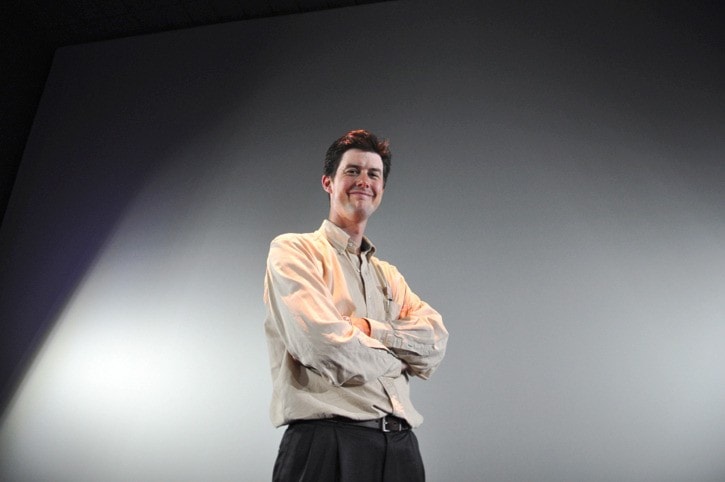It’s been the labourious routine of movie houses for 100 years – film reels arrive in heavy hexagonal metal canisters, projectionists splice together film and fire up the projector.
The days of reel changeovers, the mechanical tick of projectors and black cue dots in the corner of the screen have given way to seamless digital imagery, at least in the Cineplex Odeon in Langford.
Ushering in a new era, the seven-screen, first fully digital theatre on Vancouver Island will never see 35 millimetre film. Instead, the theater is shipped encrypted hard drives crammed with gigabytes of data, which are uploaded to servers to feed digital Christie projectors.
“The big switch from 35 mm to digital is the quality of the picture. With each run of film, the quality deteriorates. Flecks of dust can scratch the print. Over time it wears down the quality of the film,” said Kyle Moffatt, director of communications with Cineplex Odeon.
“If you take Harry Potter, what we showed on July 14 will look exactly the same as three months from now. After 200 showings it looks just as good.”
The West Shore Odeon general manager Jesse Robinson worked for six years as operations manager at SilverCity Victoria, and witnessed the industry’s transformation from film to digital. He recalls the days of lugging 50 pound canisters and helping splice reels together with trailers and commercials.
“It was a real construction process. And then we had to wind it onto platters,” Robinson said. “Now with digital, it’s like a giant MP3 file. Now it’s taking different content and compiling a playlist. It’s clicks of a button, technically speaking.”
With the rise of digital, the projectionist as a specialized job doesn’t exist anymore, at least in mainstream theatres. Projection machines are largely automated and each have their own server computers. Guarded like the combination to a bank vault, each movie requires a top secret key code.
“The key code is shipped separately. It’s so specific there is no way to take the content and use it anywhere else,” Robinson said. “It has high-end encryption.”
“If hard drive gets lost or stolen, you just can’t go an plug it into your PC and watch Captain America,” Moffatt added.
As with changing from film to digital photography, those invested in film technology resisted, Robinson said, but after years of refinements, digital movie quality is good or better than 35 mm.
“There’s no deterioration, no shaky lateral movement,” he said. “Clarity is always perfect and no one is moving lenses (on projectors).
“It’s a huge change from analogue to digital. Moving away from film is a huge change.”
Across Canada, digital cinemas will eventually become the norm, not the exception. In April Cineplex Odeon and Empire Theatres signed a partnership to transition their respective theatres to digital technology – 1,600 for Odeon and 385 for Empire. Moffatt said Odeon has about 900 more to go. “We don’t divulge (the cost) but there’s a lot that goes into a conversion.”
One of the rare connections between the old and new, oddly, are West Shore Odeon’s four 3D theatres. Harking back to the early days of the silver screen, the 3D screens are also fused with silver, to boost their luminosity. Non 3D screens are white.
Beyond flawless images, digital movies allow for quick strategic changes depending how tickets are selling. If Harry Potter is consistently selling out in three theatres, it can quickly be downloaded into a fourth projector, and conversely, a poorly received movie can be pulled and replaced in a short time.
Robinson said in the past that was tough to do – running a single film in on two machines simultaneously is possible, but tricky. Although never done, SilverCity was designed for eight of its theatres to run a single film in tandem.
Moffatt said the large investment in digital movie technology, along with digital surround sound, larger screens and auditorium seating, is the next step in the evolution of theatre as an immersive experience.
The growing home video-on-demand service that is wiping out video rental stores isn’t seen as competition, he said. Home entertainment and movie theatres are two different animals.
“Movies are made for the big screen. You can’t replicate certain things at home. And there is a social element – going out with you wife, or husband or friends, having night out, seeing a movie and talking about it after,” Moffatt said.
“There’s something to be said about a 60 foot screen versus a 42 inch TV. You can’t replicate that level of immersion. You feel that battle or explosion. You can feel the walls shake.”
Robinson said there are plenty of good reasons to be nostalgic about film, and plenty of good reasons to see it go.
“I cut my teeth on film, but I don’t miss it that much,” he said. “I don’t miss a great film getting filthy and scratched when it wasn’t threaded right into the projector. I don’t miss that at all.”
editor@goldstreamgazette.com
